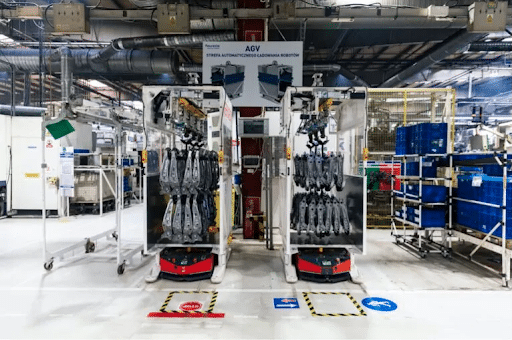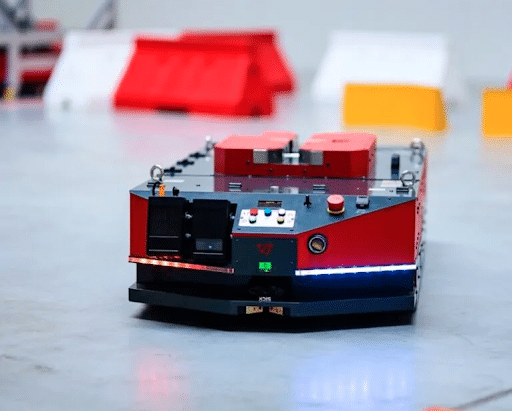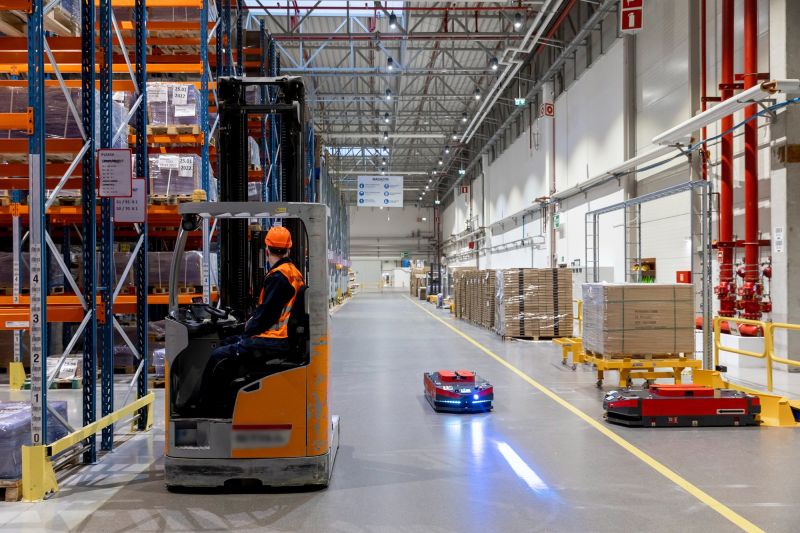Massive, stationary robotic arms – that’s what many people still think, when they hear about robotics in industrial environments. And that would be right… at least 40 years ago. Nowadays, robots can be small, light and, most of all, mobile. The so-called AMRs are becoming more and more popular each day, successfully complementing human workers or replacing them entirely in some cases (especially in hazardous zones). Continue reading, if you would like to learn more about AMRs and their impact on production and storage of goods.
AMR – what is that?
This acronym stands for Autonomous Mobile Robot and refers to a group of machines that can operate completely on their own. These aren’t just simple remotely operated underwater vehicles, trolleys moving on a predetermined path, or even flying delivery drones. AMRs don’t require operators, path planning, structural interference within the facility or even supervision. Although their current use is mainly focused on internal transport throughout warehouses and production plants, in the near future the possibilities will be practically limitless.
Autonomous Mobile Robots can be roughly divided into 2 separate groups – robots made to perform a specific task or versatile, adjustable machines. The latter could be described as a mobile platform with various interchangeable modules that can be easily fitted for the task at hand.
You can learn more about AMRs at https://versabox.eu/what-is-an-amr-robot/.
AMRs are sometimes mixed up with AGVs (Automated Guided Vehicles), which are far older and less advanced – as their name suggests, they have to be guided by a specifically designed path. Older models required current-conducting cables in the floor (which were troublesome and costly to implement/modify), but newer ones can make do with simple ferromagnetic tapes glued to the floor. An AGV can’t avoid obstacles and will simply stop if one is detected on its path. Some people even expand the AGV acronym as Autonomous Guided Vehicles, which is fundamentally wrong and contradicts itself.

How to implement Autonomous Mobile Robots?
An autonomous robot is almost effortless to implement and can be ready to work in a warehouse or a production line in mere hours after arriving there.
All you have to do after taking one out of the box is a manual drive through its intended workspace – it will scan its surroundings with laser scanners and other machine vision technology. With a simple button press and a virtual joystick in your phone, you will “show the robot around” – the data collected during this tour will be used for a virtual map, that the AMR will use to navigate itself. Autonomous Mobile Robot technology allows real-time decision-making and prevents any collisions – the robot will always choose the most efficient route to its destination, avoiding any obstacles and moving objects on its route. If you want to modify its tasks, simply adjust its objectives on the aforementioned map. AMRs use advanced mapping technology, so a single tour is enough to get everything they need to become your warehouse robots.
The map for an AMR can be easily modified afterwards – simply do another tour if the environment was heavily modified (e.g. by adding more stationary machines or new work stations). Moreover, you can add special areas to it (like speed limit or exclusion zones) that will modify how the robot behaves in certain points of the facility.

What can you gain by introducing Autonomous Mobile Robots (AMRs) into your business?
Just a single Autonomous Mobile Robot can provide you with a significant boost to efficiency and productivity. Here’s an overview of what can be achieved if you adopt Autonomous Mobile Robots in your company:
Automated intralogistics
If you have trouble with the flow of raw materials or goods within your facilities, adding autonomous mobile robot components can easily fix this – with a fleet of AMRs everything will run smoothly with minimal supervision or human intervention. These agile trolleys can take over every aspect of internal logistics, making it run like clockwork. With the right robotics development kits and passive or active attachments, AMRs can perform practically any part of intralogistics, including heavy loads handling and shipping.
And all that can be controlled by a single human operator via a WMS (Warehouse Management System) that can be integrated into already existing infrastructures and production management systems.
Constant facility operation
The batteries used in modern AMRs allow for about 6-8 hours of constant activity (which roughly equals to a full work shift). With the right planning and sufficient number of robots, your facility can continuously run 24/7/365. Excluding battery charging, AMRs don’t require any downtime such as breaks or holidays. This allows you to create fully automated warehouses, distribution centres or production plants that will work all year long.
No more staff shortages
Thanks to supporting AMRs you can overcome significant labour shortages, which are plaguing many industries nowadays. Based on the battery life alone, 2 AMRs can easily cover 3 whole shifts, which would require 3 different people. With a fleet of robots, you can delegate your personnel to more ambitious tasks and leave the “groundwork” for the machines.
Lower running costs
Many people still think that robots are expensive to run. In truth building robot solutions and introducing automated system components can be rather costly, but when they’re all set up, the running costs can get significantly lower than in the case of employing qualified personnel. When you take into account the boost in performance, the machines will pay for themselves in just a few months. Moreover, some costs can even be eliminated completely – let’s take lighting for example. Both stationary and mobile robots can work in complete darkness, which will bring down the electricity bills immensely, especially in big facilities.
Higher level of safety
AMRs are also classed as so-called cobots or collaborative robots – this term refers to machines that can safely work with and near humans. There’s no risk of them colliding with people, machinery, or infrastructure. They will never pick up more than they can carry or accidentally hook on something while passing by, which is sadly a common issue with human-operated forklifts. All these traits enable AMRs to work with all sorts of materials – they can even transport contagious laboratory specimens without the risk of spillage.
AMRs (Autonomous Mobile Robots) – summary
AMRs differ from what most people consider to be industrial robots – they’re rather small, agile, and can get practically anywhere, moving around their work environment independently, without a track or predefined route. Adapting them into warehouses and production plants can significantly boost internal transport efficiency, especially with repetitive tasks that can be a heavy burden for human employees. They will react in real time to any unexpected obstacle and take an alternative route to their target location if such need arises. Robotics technology and cutting-edge computing solutions used in their programming (such as machine learning, artificial intelligence, and modular software development) enable them to run all of intralogistics on their own. Even just a single Autonomous Mobile Robot (AMR) can make a huge difference in reducing downtimes and staff shortage related issues.














Add Comment